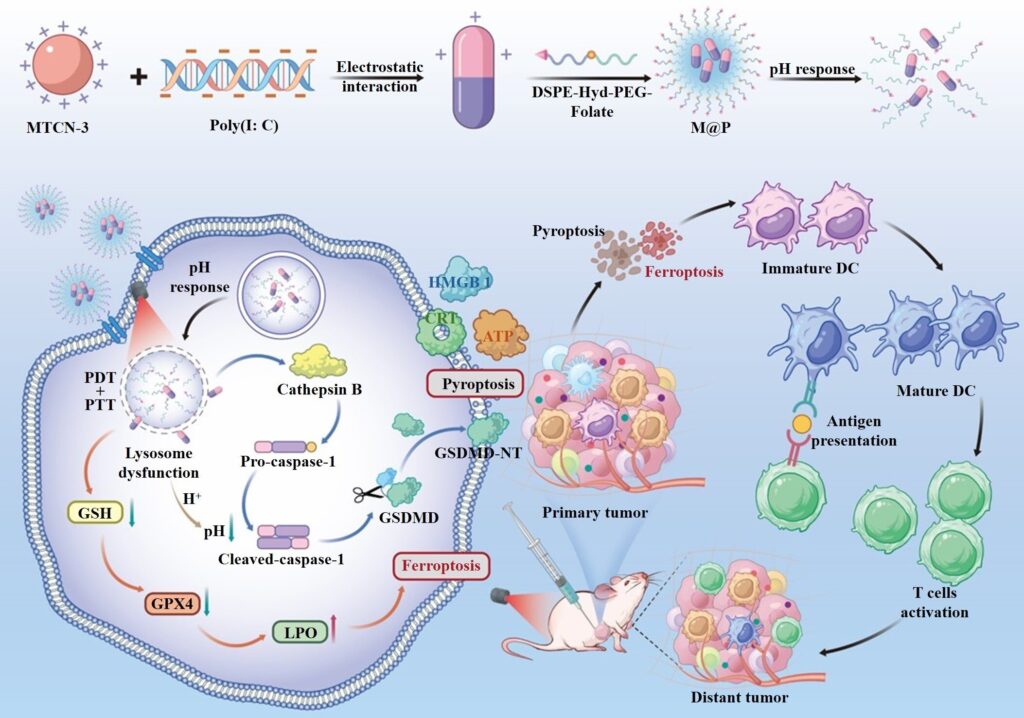by Light Publishing Center, Changchun Institute of Optics, Fine Mechanics And Physics, CAS
Photoimmunotherapy is an innovative cancer treatment that combines phototherapy with immunotherapy to selectively target and destroy cancer cells. In photoimmunotherapy, a photosensitizer or nanomaterial is introduced into the tumor tissue, and upon exposure to light of a specific wavelength, it triggers a localized therapeutic response.
This response can involve photothermal or photodynamic effects, which either directly kill tumor cells or induce immunogenic cell death. Immunogenic cell death is an immune stimulus response induced by specific forms of programmed cell death.
During the process of immunogenic cell death, cancer cells produce a series of signaling molecules called damage-associated molecular patterns. These damage-associated molecular patterns can act as natural immune adjuvants by binding to pattern recognition receptors on the surface of dendritic cells, promoting their maturation and initiating a series of cellular responses that ultimately activate innate and adaptive immune responses.
Pyroptosis and ferroptosis, as two typical forms of immunogenic cell death, have been shown to activate or modulate the immune system. In previous studies, immunotherapy mediated by pyroptosis and ferroptosis mainly relied on chemotherapeutic drugs. However, nonspecific targeting and severe side effects of traditional drugs limit their applications.
In a new paper published in Light: Science & Applications, a team of scientists, led by Professor Quan Li from Institute of Advanced Materials and School of Chemistry and Chemical Engineering, Southeast University, China, and Materials Science Graduate Program, Kent State University, U.S., and colleagues have designed and constructed a lysosome-targeted photoinduced pyroptosis and ferroptosis theranostic nanoplatform M@P by self-assembly of photosensitizer MTCN-3 and immunoadjuvant Poly(I: C), which is further encapsulated in amphiphilic polymers.
This nanoplatform can actively target tumor regions and accumulate in the lysosomes of tumor cells. Upon light irradiation, it can induce lysosomal dysfunction by generating a large amount of reactive oxygen species and heat, leading to the pyroptosis and ferroptosis of tumor cells. This process results in immunogenic cell death and can further enhance the efficacy of immunotherapy when combined with the immunoadjuvant Poly(I: C).
The immunotherapeutic efficacy of M@P is further demonstrated in a tumor-bearing mouse model with poor immunogenicity. M@P can promote the production of tumor-specific antigens and the maturation of dendritic cells, leading to the proliferation of activated T cells, thereby inducing a robust systemic antitumor immune response.
On the ninth day of treatment, the growth of primary and distant tumors in mice was effectively inhibited. The research provides a novel strategy for pyroptosis and ferroptosis dual function inducer design, which will benefit further advancement in the field of cancer photoimmunotherapy.
Provided by
Light Publishing Center, Changchun Institute of Optics, Fine Mechanics And Physics, CAS


